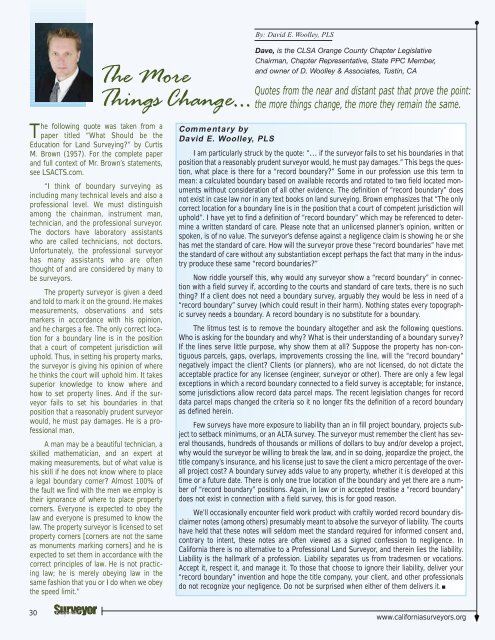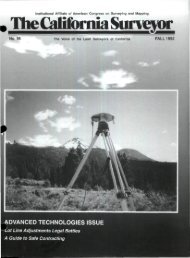Sacramento Surveyors Visit the NGS Airborne Gravimeter - CLSA
Sacramento Surveyors Visit the NGS Airborne Gravimeter - CLSA
Sacramento Surveyors Visit the NGS Airborne Gravimeter - CLSA
You also want an ePaper? Increase the reach of your titles
YUMPU automatically turns print PDFs into web optimized ePapers that Google loves.
The following quote was taken from a<br />
paper titled “What Should be <strong>the</strong><br />
Education for Land Surveying?” by Curtis<br />
M. Brown (1957). For <strong>the</strong> complete paper<br />
and full context of Mr. Brown’s statements,<br />
see LSACTS.com.<br />
“I think of boundary surveying as<br />
including many technical levels and also a<br />
professional level. We must distinguish<br />
among <strong>the</strong> chainman, instrument man,<br />
technician, and <strong>the</strong> professional surveyor.<br />
The doctors have laboratory assistants<br />
who are called technicians, not doctors.<br />
Unfortunately, <strong>the</strong> professional surveyor<br />
has many assistants who are often<br />
thought of and are considered by many to<br />
be surveyors.<br />
The property surveyor is given a deed<br />
and told to mark it on <strong>the</strong> ground. He makes<br />
measurements, observations and sets<br />
markers in accordance with his opinion,<br />
and he charges a fee. The only correct location<br />
for a boundary line is in <strong>the</strong> position<br />
that a court of competent jurisdiction will<br />
uphold. Thus, in setting his property marks,<br />
<strong>the</strong> surveyor is giving his opinion of where<br />
he thinks <strong>the</strong> court will uphold him. It takes<br />
superior knowledge to know where and<br />
how to set property lines. And if <strong>the</strong> surveyor<br />
fails to set his boundaries in that<br />
position that a reasonably prudent surveyor<br />
would, he must pay damages. He is a professional<br />
man.<br />
A man may be a beautiful technician, a<br />
skilled ma<strong>the</strong>matician, and an expert at<br />
making measurements, but of what value is<br />
his skill if he does not know where to place<br />
a legal boundary corner? Almost 100% of<br />
<strong>the</strong> fault we find with <strong>the</strong> men we employ is<br />
<strong>the</strong>ir ignorance of where to place property<br />
corners. Everyone is expected to obey <strong>the</strong><br />
law and everyone is presumed to know <strong>the</strong><br />
law. The property surveyor is licensed to set<br />
property corners [corners are not <strong>the</strong> same<br />
as monuments marking corners] and he is<br />
expected to set <strong>the</strong>m in accordance with <strong>the</strong><br />
correct principles of law. He is not practicing<br />
law; he is merely obeying law in <strong>the</strong><br />
same fashion that you or I do when we obey<br />
<strong>the</strong> speed limit.”<br />
The More<br />
Things Change...<br />
Commentary by<br />
David E. Woolley, PLS<br />
By: David E. Woolley, PLS<br />
Dave, is <strong>the</strong> <strong>CLSA</strong> Orange County Chapter Legislative<br />
Chairman, Chapter Representative, State PPC Member,<br />
and owner of D. Woolley & Associates, Tustin, CA<br />
Quotes from <strong>the</strong> near and distant past that prove <strong>the</strong> point:<br />
<strong>the</strong> more things change, <strong>the</strong> more <strong>the</strong>y remain <strong>the</strong> same.<br />
I am particularly struck by <strong>the</strong> quote: “… if <strong>the</strong> surveyor fails to set his boundaries in that<br />
position that a reasonably prudent surveyor would, he must pay damages.” This begs <strong>the</strong> question,<br />
what place is <strong>the</strong>re for a “record boundary?” Some in our profession use this term to<br />
mean: a calculated boundary based on available records and rotated to two field located monuments<br />
without consideration of all o<strong>the</strong>r evidence. The definition of “record boundary” does<br />
not exist in case law nor in any text books on land surveying. Brown emphasizes that “The only<br />
correct location for a boundary line is in <strong>the</strong> position that a court of competent jurisdiction will<br />
uphold”. I have yet to find a definition of “record boundary” which may be referenced to determine<br />
a written standard of care. Please note that an unlicensed planner’s opinion, written or<br />
spoken, is of no value. The surveyor’s defense against a negligence claim is showing he or she<br />
has met <strong>the</strong> standard of care. How will <strong>the</strong> surveyor prove <strong>the</strong>se “record boundaries” have met<br />
<strong>the</strong> standard of care without any substantiation except perhaps <strong>the</strong> fact that many in <strong>the</strong> industry<br />
produce <strong>the</strong>se same “record boundaries?”<br />
Now riddle yourself this, why would any surveyor show a “record boundary” in connection<br />
with a field survey if, according to <strong>the</strong> courts and standard of care texts, <strong>the</strong>re is no such<br />
thing? If a client does not need a boundary survey, arguably <strong>the</strong>y would be less in need of a<br />
“record boundary” survey (which could result in <strong>the</strong>ir harm). Nothing states every topographic<br />
survey needs a boundary. A record boundary is no substitute for a boundary.<br />
The litmus test is to remove <strong>the</strong> boundary altoge<strong>the</strong>r and ask <strong>the</strong> following questions.<br />
Who is asking for <strong>the</strong> boundary and why? What is <strong>the</strong>ir understanding of a boundary survey?<br />
If <strong>the</strong> lines serve little purpose, why show <strong>the</strong>m at all? Suppose <strong>the</strong> property has non-contiguous<br />
parcels, gaps, overlaps, improvements crossing <strong>the</strong> line, will <strong>the</strong> “record boundary”<br />
negatively impact <strong>the</strong> client? Clients (or planners), who are not licensed, do not dictate <strong>the</strong><br />
acceptable practice for any licensee (engineer, surveyor or o<strong>the</strong>r). There are only a few legal<br />
exceptions in which a record boundary connected to a field survey is acceptable; for instance,<br />
some jurisdictions allow record data parcel maps. The recent legislation changes for record<br />
data parcel maps changed <strong>the</strong> criteria so it no longer fits <strong>the</strong> definition of a record boundary<br />
as defined herein.<br />
Few surveys have more exposure to liability than an in fill project boundary, projects subject<br />
to setback minimums, or an ALTA survey. The surveyor must remember <strong>the</strong> client has several<br />
thousands, hundreds of thousands or millions of dollars to buy and/or develop a project,<br />
why would <strong>the</strong> surveyor be willing to break <strong>the</strong> law, and in so doing, jeopardize <strong>the</strong> project, <strong>the</strong><br />
title company’s insurance, and his license just to save <strong>the</strong> client a micro percentage of <strong>the</strong> overall<br />
project cost? A boundary survey adds value to any property, whe<strong>the</strong>r it is developed at this<br />
time or a future date. There is only one true location of <strong>the</strong> boundary and yet <strong>the</strong>re are a number<br />
of “record boundary” positions. Again, in law or in accepted treatise a “record boundary”<br />
does not exist in connection with a field survey, this is for good reason.<br />
We’ll occasionally encounter field work product with craftily worded record boundary disclaimer<br />
notes (among o<strong>the</strong>rs) presumably meant to absolve <strong>the</strong> surveyor of liability. The courts<br />
have held that <strong>the</strong>se notes will seldom meet <strong>the</strong> standard required for informed consent and,<br />
contrary to intent, <strong>the</strong>se notes are often viewed as a signed confession to negligence. In<br />
California <strong>the</strong>re is no alternative to a Professional Land Surveyor, and <strong>the</strong>rein lies <strong>the</strong> liability.<br />
Liability is <strong>the</strong> hallmark of a profession. Liability separates us from tradesmen or vocations.<br />
Accept it, respect it, and manage it. To those that choose to ignore <strong>the</strong>ir liability, deliver your<br />
“record boundary” invention and hope <strong>the</strong> title company, your client, and o<strong>the</strong>r professionals<br />
do not recognize your negligence. Do not be surprised when ei<strong>the</strong>r of <strong>the</strong>m delivers it.<br />
30<br />
www.californiasurveyors.org
















